Hello, young woodworker! Building a picture frame or a neat box is fun, but getting the corners just right can be tricky.
This Miter Angle Calculator is like a trusty and tricky guide. It tells you the exact angle to set your saw for perfect miter joints, where the wood meets at sharp edges.
A miter angle depends on how many sides your shape has—like 45 degrees for a four-sided frame to make a 90-degree corner. It uses board feet to help you measure your wood, which is 144 cubic inches, or a block one foot by one foot by one inch.
This tool makes your cuts clean and your projects look great, whether it’s a small shelf or a big frame!
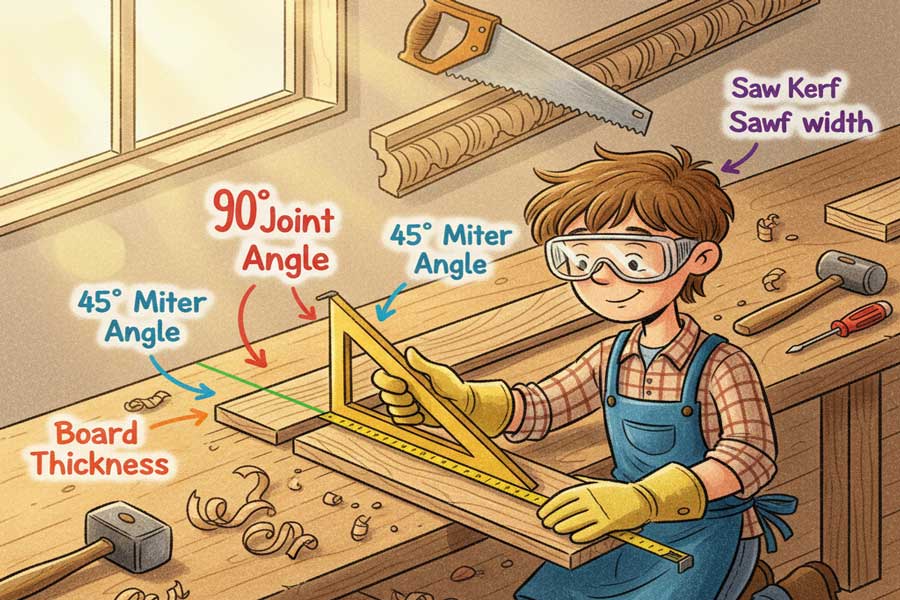
Miter Angle Calculator
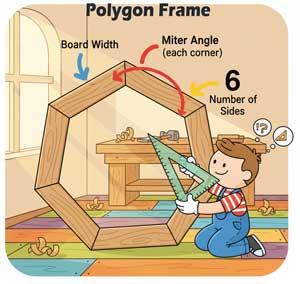

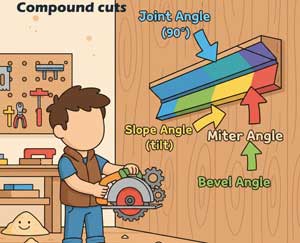
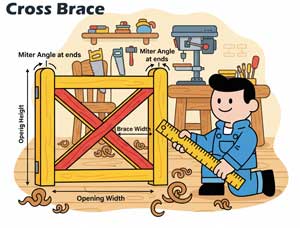
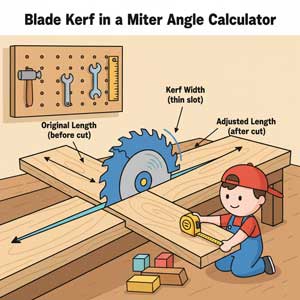
Note: Free Cut List Optimizer calculator also available to calculate it easily.
The Formula This Calculator Uses
This tool uses basic math rules for each part.
- For polygon frames: Miter Angle = 90° - (180° / Number of Sides)
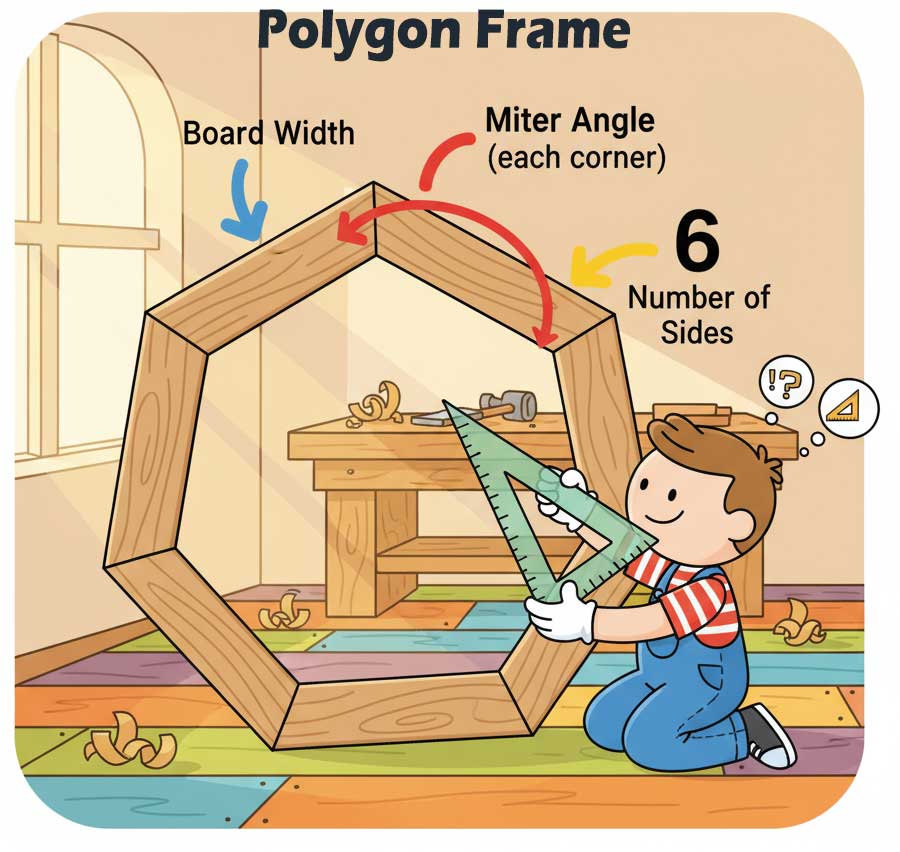
- For simple corners: Miter Angle = Joint Angle / 2 (same boards) Narrow Board Angle = arctan(Narrow Width * sin(Joint Angle) / (Wide Width + Narrow Width * cos(Joint Angle))) Wide Board Angle = Joint Angle - Narrow Board Angle.
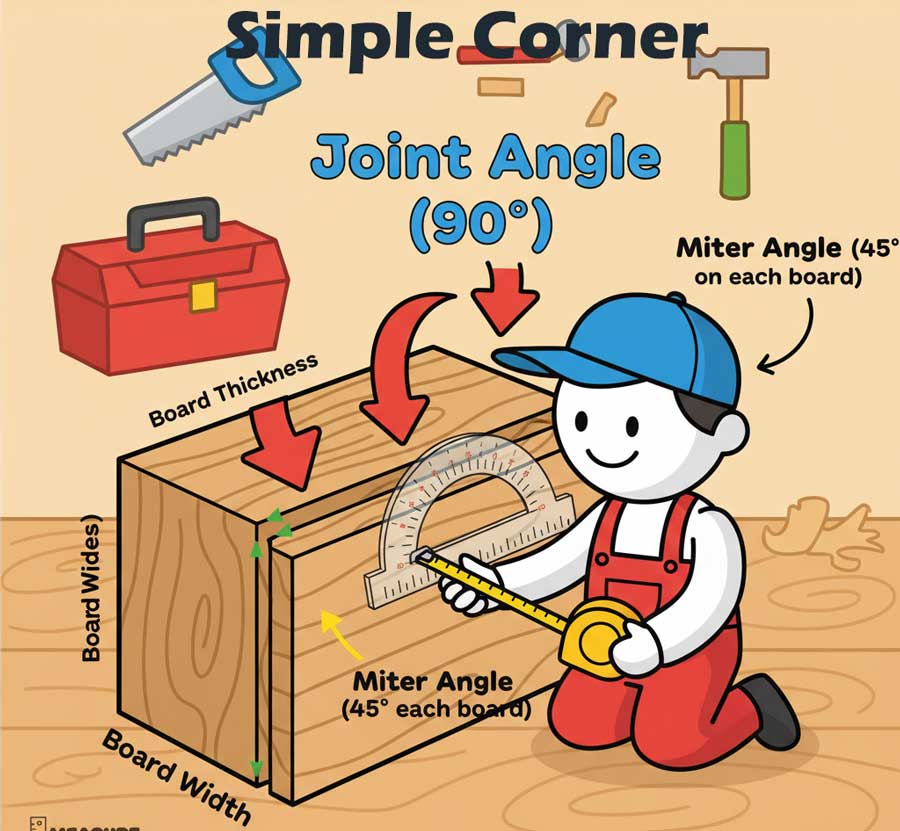
- For compound cuts: Miter Angle = arctan(tan(Joint Angle / 2) / cos(Slope Angle)) Bevel Angle = arctan(sin(Slope Angle) * tan(Joint Angle / 2)).

- For cross braces: Miter Angle = arctan(Height / Width) Brace Length = sqrt(Width^2 + Height^2) + 2 * Brace Width / sin(Miter Angle).
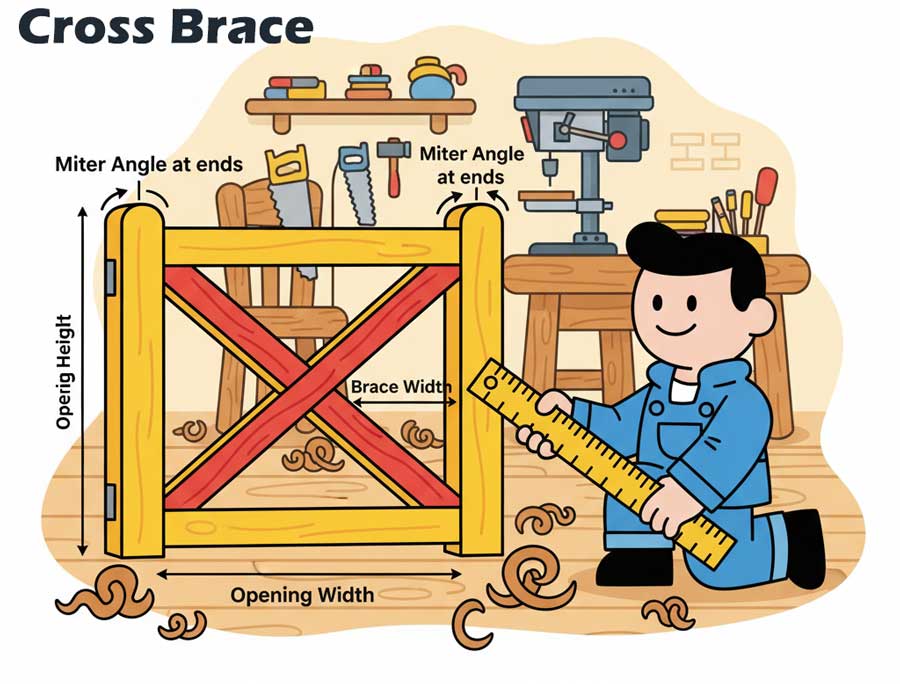
- For blade kerf: Adjusted Length = Original Length + Kerf Width / tan(Miter Angle).
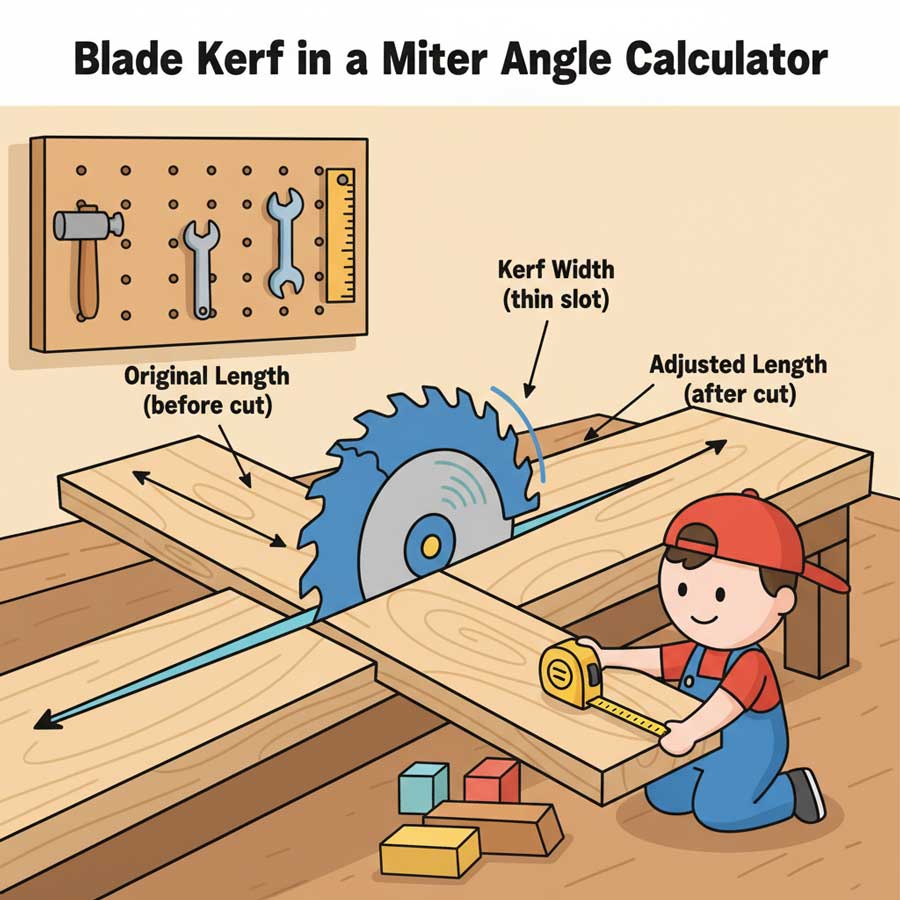
Saw Setting = 90° - Miter Angle (for many cuts)
These help your wood join right. Use degrees for angles. Pick inches or cm for sizes.
How to Use the Miter Angle Calculator
Hey there, young woodworker! This calculator is your very own helper at home, like a friendly teacher right by your side. It’s super easy to use, and I’ll guide you step by step so you can measure and cut wood all on your own. Let’s get started and make something awesome—safely and with lots of fun!
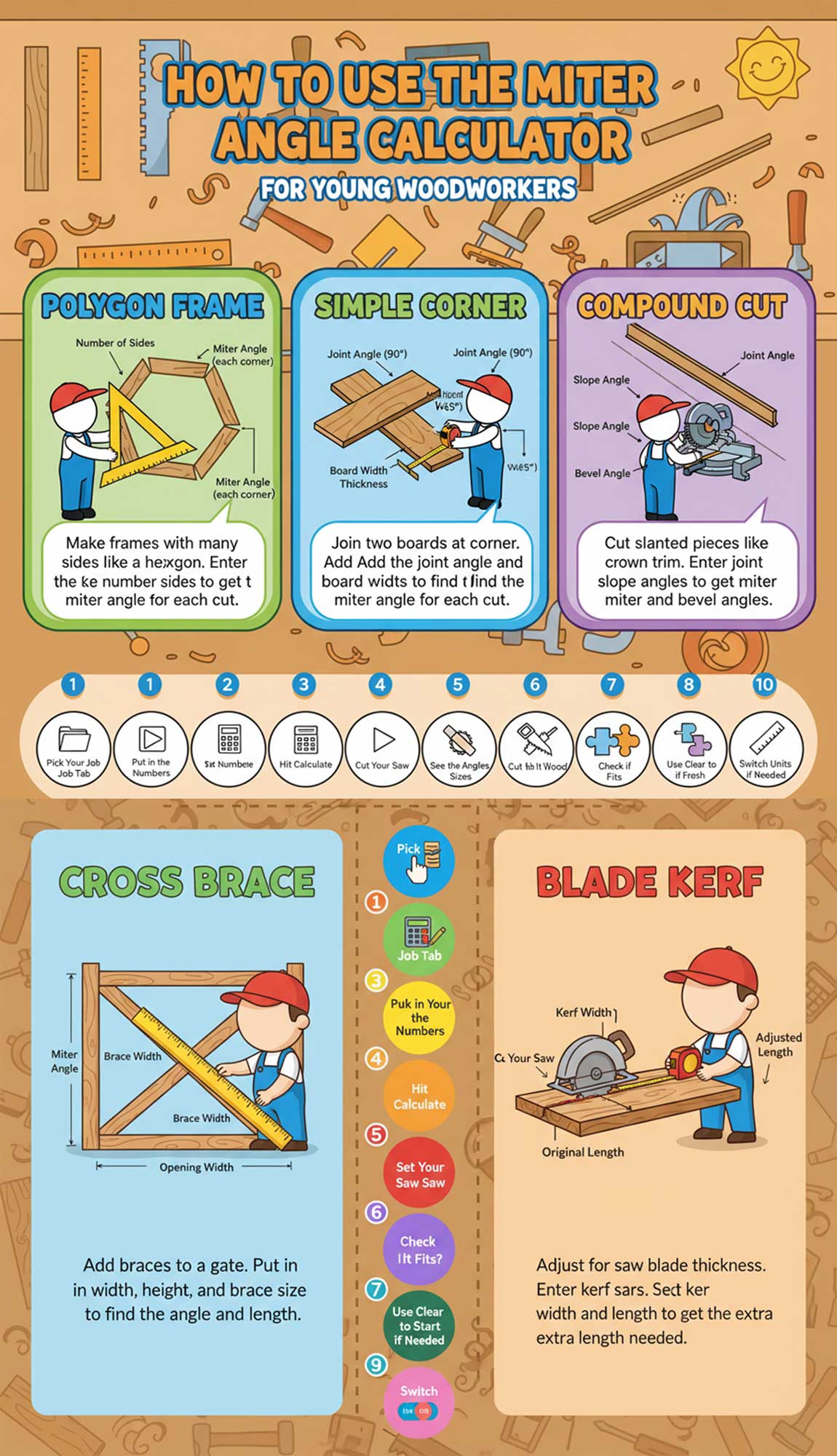
- Pick Your Job Tab First, look at the top of the calculator where you see tabs like "Polygon Frame," "Simple Corner," "Compound Cut," "Cross Brace," and "Blade Kerf." Click the one that matches what you’re making, like a frame or a gate. This tells the calculator what kind of cut you need.
- Put in the Numbers Now, type the numbers it asks for. For example, if you’re doing a "Polygon Frame," enter how many sides your shape has (like 4 for a square). For "Simple Corner," add the joint angle and the widths of your boards. Use a ruler or tape measure to check the sizes of your wood. Write down the numbers carefully!
- Hit Calculate Press the "Calculate" button under the numbers. This is like asking your calculator teacher to do the math for you. It will figure out the angles and sizes you need to cut.
- See the Angles and Sizes Look at the answer that pops up! It will show you the miter angle (the cut angle) and sometimes other sizes, like the length for a brace. Read it slowly and write it down so you don’t forget.
- Set Your Saw Take your saw and set it to the angle the calculator gave you. If it says "Saw: 45°," turn the saw handle until it matches 45 degrees on its scale. Make sure it’s locked in place so it doesn’t move.
- Cut the Wood Hold your wood steady on a flat table. Line up the saw with the spot you want to cut. Push the saw gently and cut along the line. Wear gloves if you have them to keep your hands safe. Take your time!
- Check if It Fits Put the pieces together where they should join. If they match up nice and tight, you did great! If not, don’t worry—check your numbers or saw angle and try again. It’s all part of learning at home!
- Use Clear to Start Fresh If you mess up or want to try a new project, press the "Clear" button. This wipes everything clean, like a new page in your notebook, so you can start over.
- Switch Units if Needed At the top, there’s a "Units" box with "Inches" or "Centimeters." If your ruler uses centimeters, pick that. If it’s inches, leave it. This helps the calculator match your measurements.
- Stay Safe and Have Fun! Always work slowly and ask an adult to watch if you’re new. Keep your fingers away from the saw blade. Enjoy building—every cut makes you a better woodworker at home!
This is your own guide, like a teacher living in your calculator. Practice these steps, and soon you’ll be making frames and gates like a pro—all by yourself!
Keep your tape steady and measure twice. This will help you cut perfect corners for your next wood project!
How do you calculate mitre angle?
You take the angle of the corner and divide it by two.
For example: if your wall corner is 90°, each piece of trim should be cut at 45°.
This works because two boards meet in the middle. Each one covers half the angle.
How to make a 45 degree angle with a miter saw?
Set your miter saw to 45° on the gauge and cut straight down.
Think of it like slicing a sandwich diagonally—you’re just making a clean half-angle cut.
How to find the angle of a corner?
Use a protractor, angle finder, or even two scrap pieces of wood.
If the corner is 90°, you know it’s a right angle. For odd corners, measure with an angle finder, then divide that number by two to get your miter angle.
How to calculate an angle formula?
For miters: Miter angle = Corner angle ÷ 2.
That’s the only formula you really need in woodworking for trim.
How to measure for a 45 degree miter?
Mark your cut length, then swing your saw or square to 45°. Line it up, and cut.
How to mitre a 120 degree angle?
Divide 120° by 2 = 60°.
So, you cut each board at 60° on the saw (or the nearest mark your saw has).
Is a mitre always 45 degrees?
No. 45° is just common because most walls are 90°. But any corner—like 120° or 135°—has its own miter angle (corner ÷ 2).
How to cut perfect 45 degree angles for trim?
- Use a sharp blade.
- Clamp the trim so it doesn’t move.
- Cut slow and steady.
And always test with scrap first. Saves headaches.
How to cut perfect 45 degree angles without a miter saw?
You can use:
- A speed square marked at 45° and a hand saw.
- Or a miter box (plastic or wood jig with slots already at 45°).
I’ve done this with nothing but a $10 miter box, and it came out pretty clean.
How to calculate angle for cutting wood?
Measure the corner angle → divide by two → set your saw to that.
That’s it. Same rule every time.
How to measure a 45 degree angle with a square?
A speed square has a 45° side built in. Just place it on the edge of the board and draw the diagonal line.
How to cut wood at a certain angle?
Mark the angle with a protractor, angle finder, or square. Then follow the line with a saw (hand saw, circular, or miter saw).
How do you calculate the bevel angle?
Bevel is the tilt of the blade, not the swivel of the saw table.
If you’re making a compound cut (like crown molding), you’ll need both the miter angle (corner ÷ 2) and the bevel (based on crown’s “spring angle”). Most miter saw manuals have a chart for this.
👉 Quick recap:
- Normal corner? Divide by 2.
- 90° wall? Cut 45°.
- Odd corner? Still divide by 2.
- No saw? Use a square or miter box.
✂️ Miter & Angle Cutting Cheat Sheet
| Question | Quick Answer | Details / Example |
|---|---|---|
| How do you calculate miter angle? | Divide corner angle by 2 | 90° corner → cut 45° on each piece |
| How to make a 45° angle with a miter saw? | Set saw to 45° and cut | Like slicing a sandwich diagonally |
| How to find the angle of a corner? | Use protractor/angle finder | Odd corner? Measure, then divide by 2 |
| Formula for angle? | Miter angle = Corner ÷ 2 | Works for any corner |
| How to measure for 45° miter? | Mark length, cut at 45° | Use saw gauge or square |
| How to miter a 120° angle? | Cut each at 60° | 120 ÷ 2 = 60 |
| Is a miter always 45°? | No | 45° only for 90° corners |
| Perfect 45° trim cuts? | Sharp blade, clamp, cut slow | Always test on scrap first |
| Cut 45° without a miter saw? | Use speed square or miter box | Hand saw can do it too |
| How to calculate angle for wood? | Corner ÷ 2 | Same rule every time |
| Measure 45° with a square? | Use speed square’s 45° side | Place, mark, cut |
| Cut wood at certain angle? | Mark with square/protractor | Follow line with saw |
| How to calculate bevel angle? | Depends on cut (compound needs chart) | For crown molding, use miter + bevel together |
Miter Angle Calculation Example with Figure

Here you go—two simple diagrams:
- On the left: a 90° corner split into 45° cuts.
- On the right: a 120° corner split into 60° cuts.
This shows the golden rule: whatever the corner is, divide by two for your miter angle.
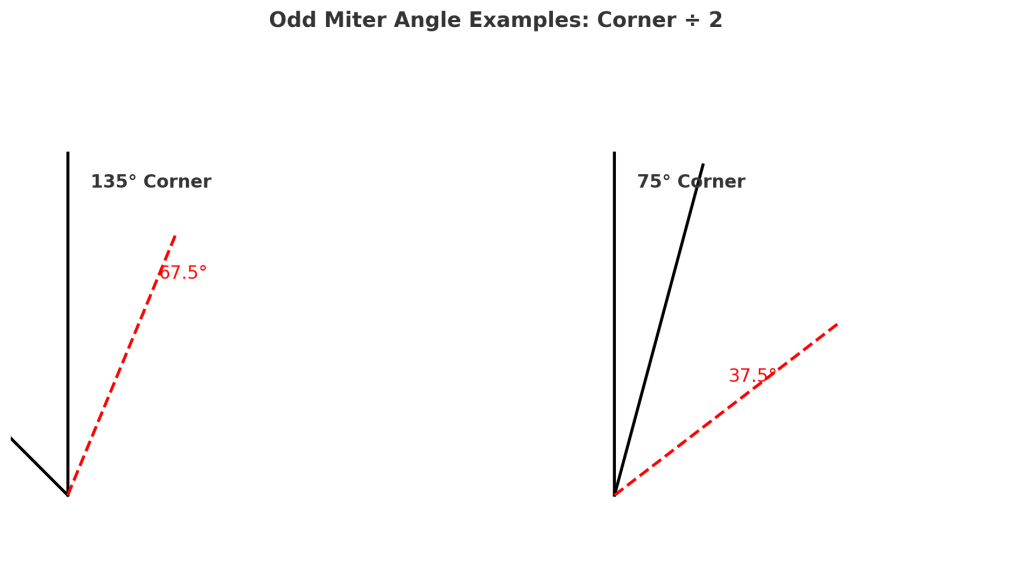
Here’s the follow-up with odd angles:
- Left: a 135° corner → each cut is 67.5°.
- Right: a 75° corner → each cut is 37.5°.
Same rule every time: measure the corner, divide by two, and that’s your miter cut.

